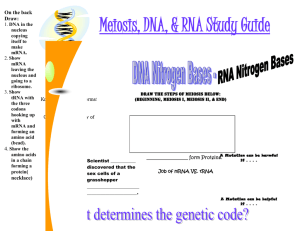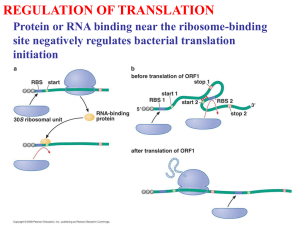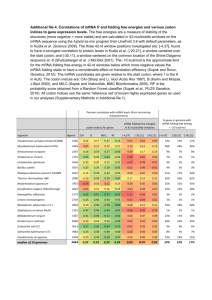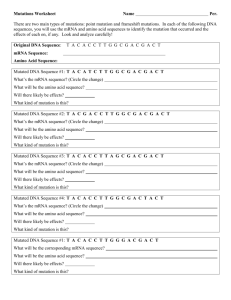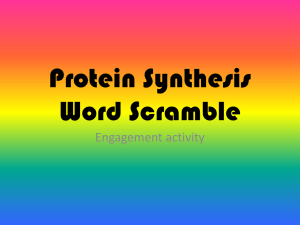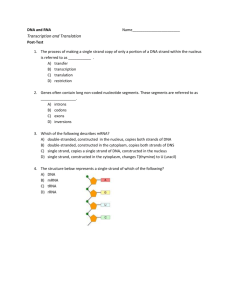Bio101 Midterm II Study Guide 10/25/10
advertisement
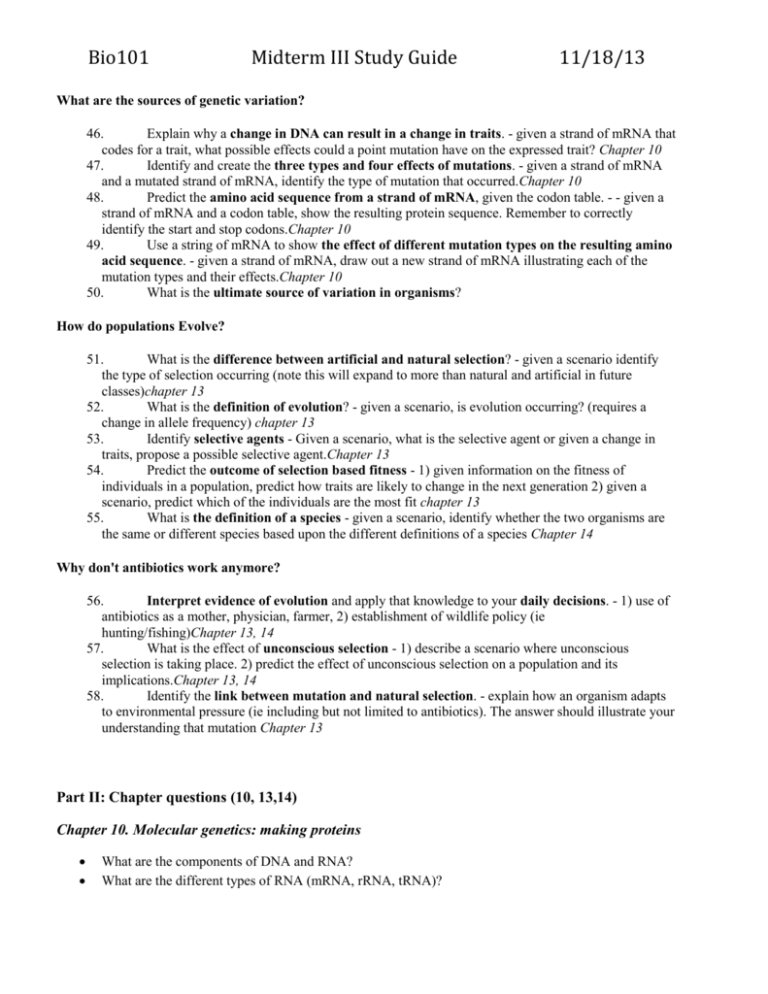
Bio101 Midterm III Study Guide 11/18/13 What are the sources of genetic variation? 46. Explain why a change in DNA can result in a change in traits. - given a strand of mRNA that codes for a trait, what possible effects could a point mutation have on the expressed trait? Chapter 10 47. Identify and create the three types and four effects of mutations. - given a strand of mRNA and a mutated strand of mRNA, identify the type of mutation that occurred.Chapter 10 48. Predict the amino acid sequence from a strand of mRNA, given the codon table. - - given a strand of mRNA and a codon table, show the resulting protein sequence. Remember to correctly identify the start and stop codons.Chapter 10 49. Use a string of mRNA to show the effect of different mutation types on the resulting amino acid sequence. - given a strand of mRNA, draw out a new strand of mRNA illustrating each of the mutation types and their effects.Chapter 10 50. What is the ultimate source of variation in organisms? How do populations Evolve? 51. What is the difference between artificial and natural selection? - given a scenario identify the type of selection occurring (note this will expand to more than natural and artificial in future classes)chapter 13 52. What is the definition of evolution? - given a scenario, is evolution occurring? (requires a change in allele frequency) chapter 13 53. Identify selective agents - Given a scenario, what is the selective agent or given a change in traits, propose a possible selective agent.Chapter 13 54. Predict the outcome of selection based fitness - 1) given information on the fitness of individuals in a population, predict how traits are likely to change in the next generation 2) given a scenario, predict which of the individuals are the most fit chapter 13 55. What is the definition of a species - given a scenario, identify whether the two organisms are the same or different species based upon the different definitions of a species Chapter 14 Why don't antibiotics work anymore? 56. Interpret evidence of evolution and apply that knowledge to your daily decisions. - 1) use of antibiotics as a mother, physician, farmer, 2) establishment of wildlife policy (ie hunting/fishing)Chapter 13, 14 57. What is the effect of unconscious selection - 1) describe a scenario where unconscious selection is taking place. 2) predict the effect of unconscious selection on a population and its implications.Chapter 13, 14 58. Identify the link between mutation and natural selection. - explain how an organism adapts to environmental pressure (ie including but not limited to antibiotics). The answer should illustrate your understanding that mutation Chapter 13 Part II: Chapter questions (10, 13,14) Chapter 10. Molecular genetics: making proteins What are the components of DNA and RNA? What are the different types of RNA (mRNA, rRNA, tRNA)? Bio101 Midterm III Study Guide 11/18/13 How does DNA code for proteins? (process of transcription and translation) o What is a codon? o How does the code for a protein move from DNA to the final protein? o What is the role of ribosomes? o Read a codon table (note do not memorize the codon table) (note: part of variation section. May not be included in this midterm) How would a mutation affect a protein? (note: part of variation section. May not be included in this midterm) What are the different types of proteins? (note: part of variation section. May not be included in this midterm) Chapter 13. How Populations Evolve Before we started the section on evolution we were concerned with sources of variation. Why is variation important for natural selection? Read the observations and inferences made by Darwin concerning Natural Selection. Where does Meiosis fit in? How does genetics play a role in fitness? Do all organisms born have the same likelihood of survival? Is the survival of an individual likely to be based upon its traits? What is the gene pool? How does it relate to evolution? Other than Natural Selection, what processes can alter gene frequencies? What is the fundamental distinction between Natural selection and these other processes? What are stabilizing, disruptive and directional selection? How would you determine the type of selection a population was under? What limits natural selection? Predict the effect of selection on phenotype given fitness data. Identify and create scenarios illustrating different types of selection Determine whether a population is evolving Chapter 14. The Origin of Species What are the different ways that scientists define species? Although species classified by one definition are usually also defined by the other methods, there are exceptions. Try to think of examples of organisms that might be classified differently depending upon the species definition used. Use your imagination. Speciation occurs when a barrier separates populations within a species. What are the different methods described in the book? In addition to the examples in the book, try to think of other possible examples. When would adaptive radiation occur? How does is this process related to the founder effect and bottlenecks?



